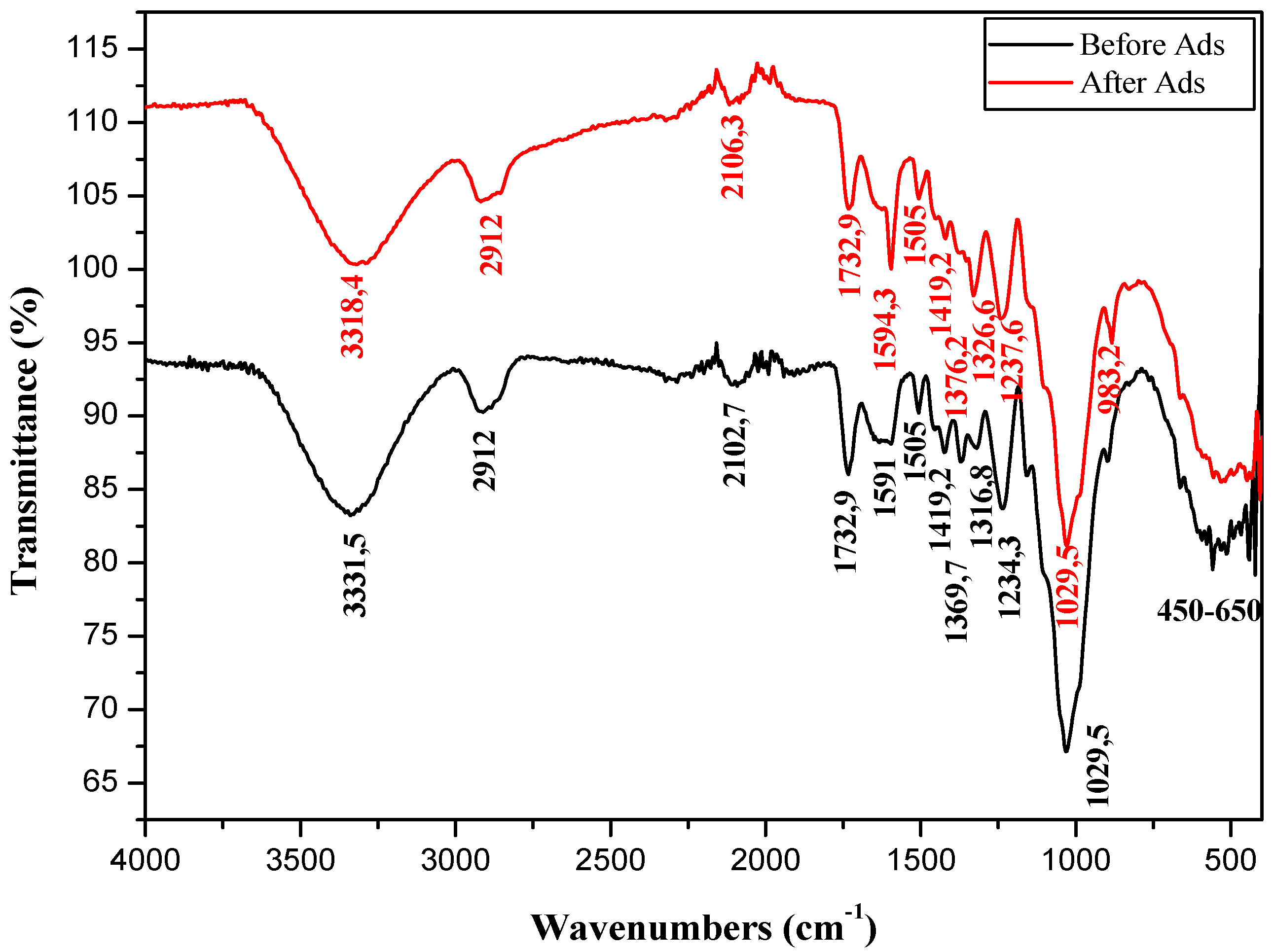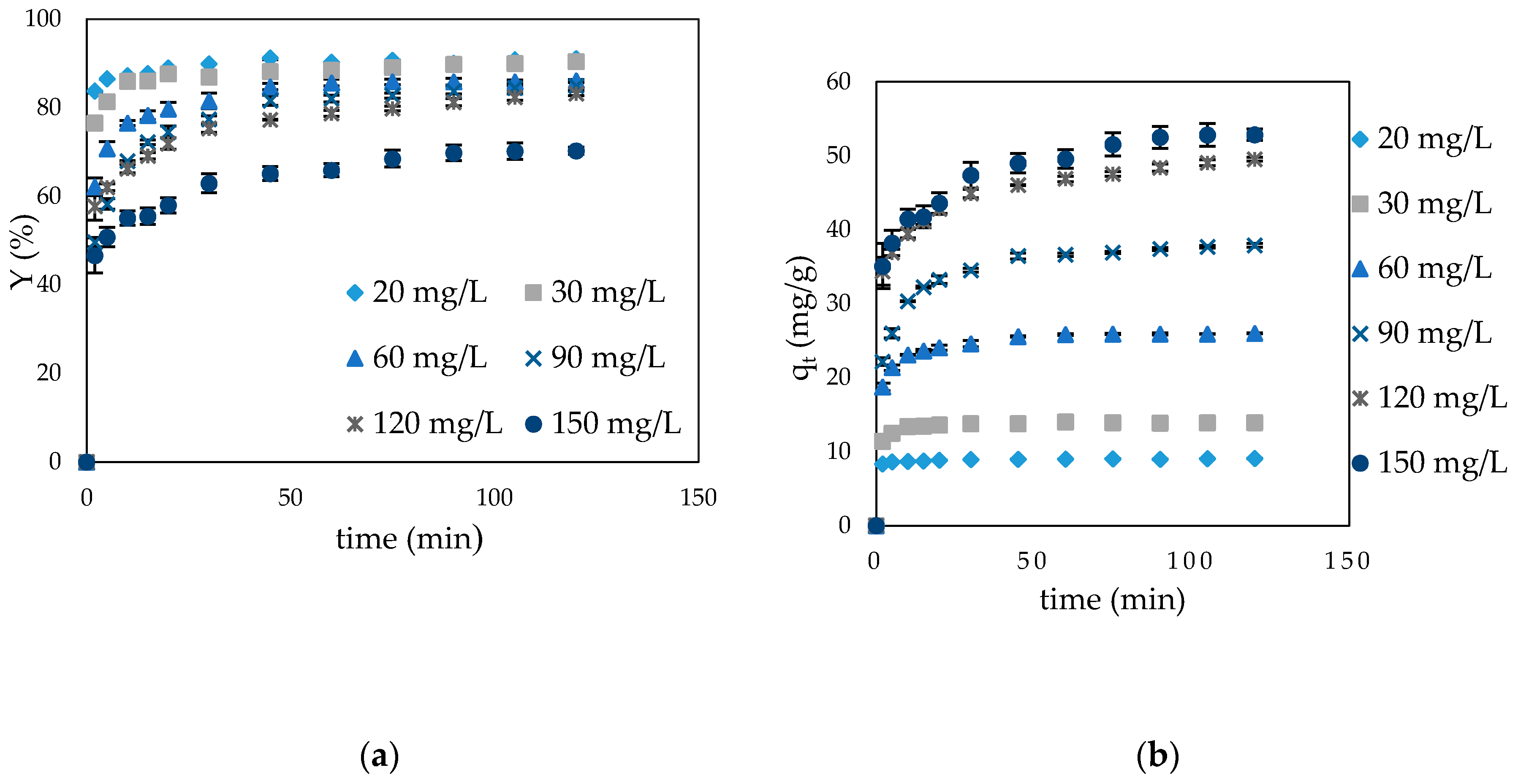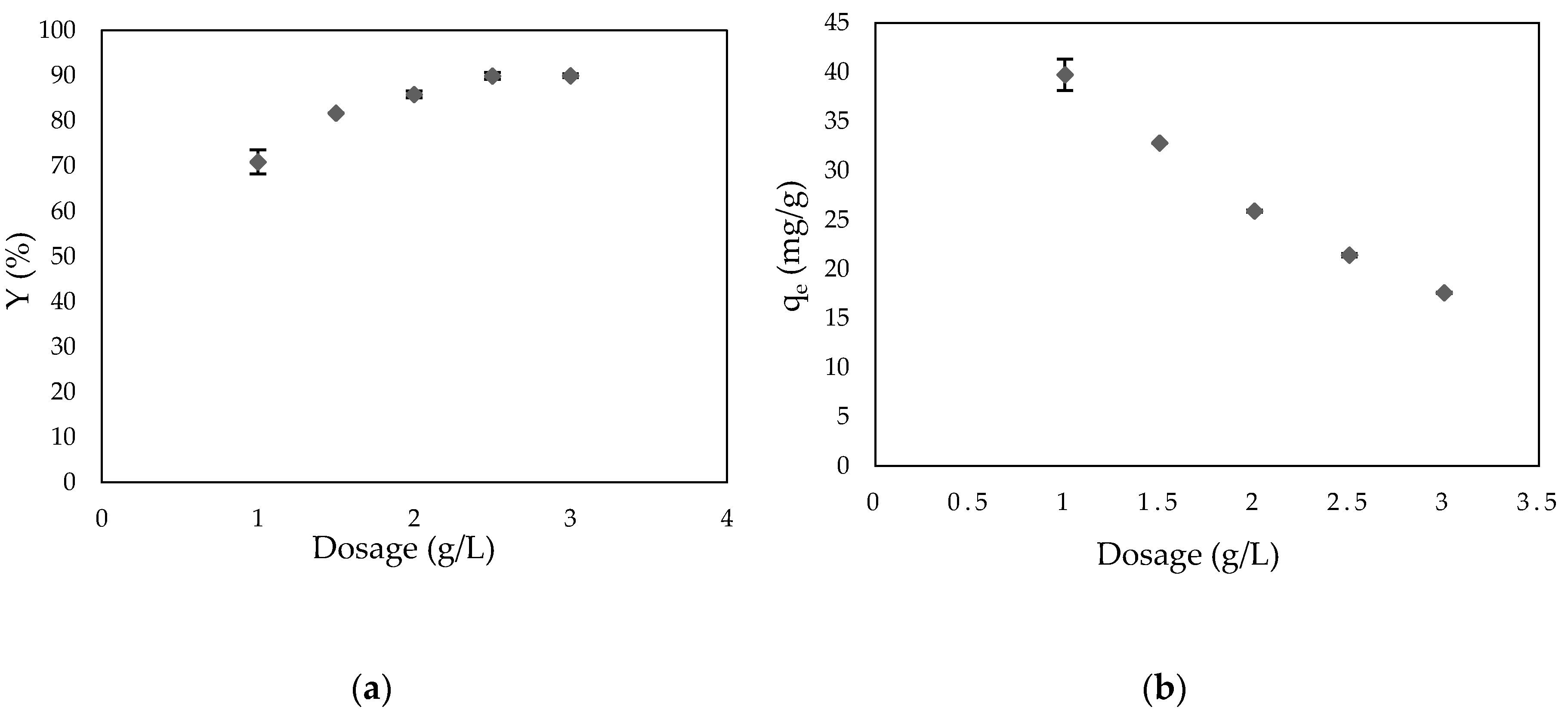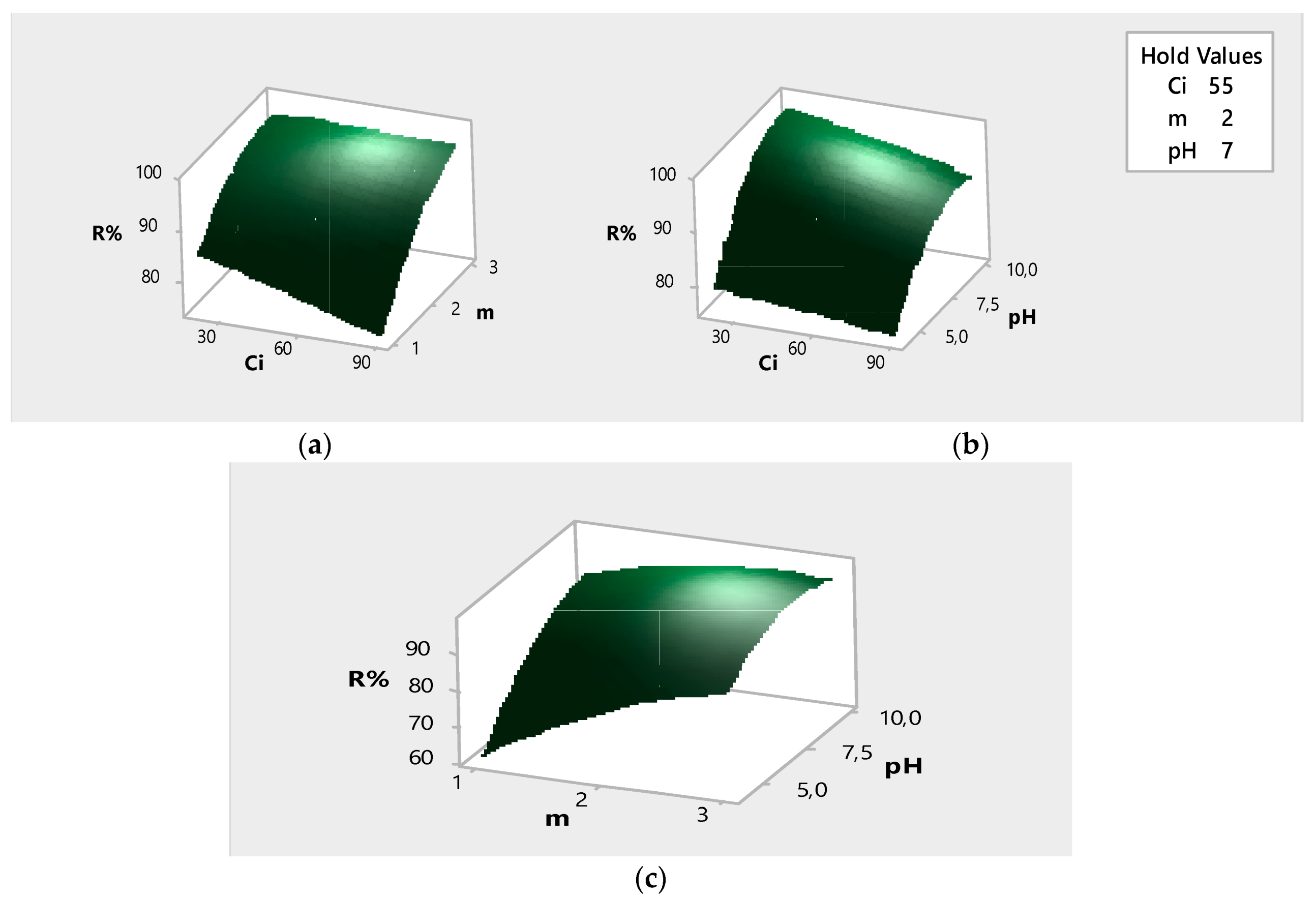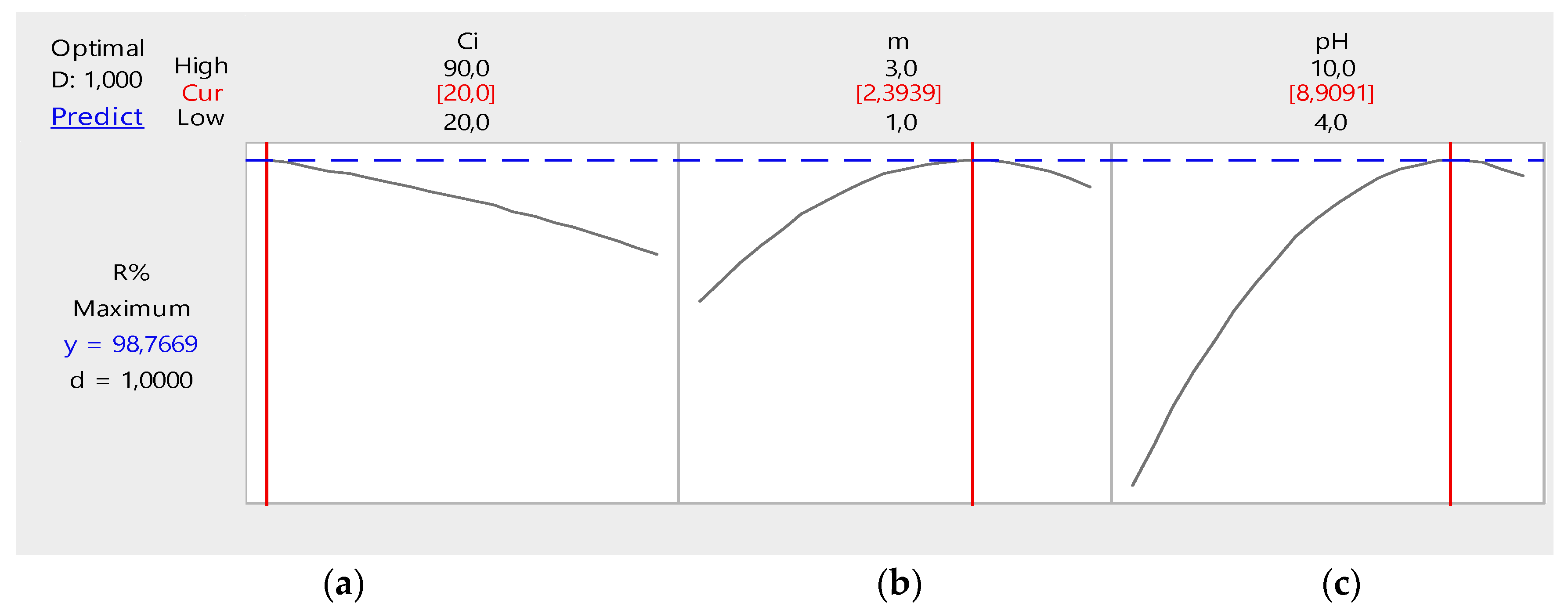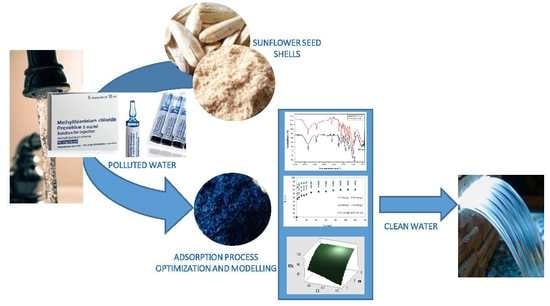1. Introduction
There has been a great deal of concern about the detection of pharmaceuticals and personal care products in soil, sediments, surface and groundwater [
1] as they have become major pollutants due to their low biodegradability, high persistence, and facile bioaccumulation [
2]. Among these products, methylthioninium chloride (MC), which is part of a type of medication derived from phenothiazines, has been widely used in a variety of medical treatments, such as methemoglobinemia [
3] and lymphatic mapping/sentinel lymphadenectomy in staging melanoma and breast cancer [
4]. It has also been used as a therapeutic agent in neurodegenerative diseases [
5,
6]. This product is not only used in the pharmaceutical field, but it is also used in several other industrial fields including textiles, leather, cosmetics, paper, printing, plastic and food [
7,
8,
9].Therefore, MC is often present in the various effluents that are discharged into the environment. Thus, the continuous release of this pollutant into the environment significantly affects human health and aquatic systems [
9,
10].
Therefore, the treatment of these effluents by appropriate techniques is very necessary [
9,
11]. For this purpose, several physical, chemical and biological methods have been developed including coagulation and flocculation, membrane separation, reverse osmosis, oxidation and co-precipitation [
9,
12]. The use of an inexpensive and effective method is very important [
11,
13]. The adsorption technique has certain advantages; it is a simple and easy technique, it costs less and it is respectful of the environment [
14,
15]. Activated carbon is the most commonly used adsorbent due to its very high adsorption capacity [
16,
17,
18], but the disadvantage is that it is expensive [
16]. For this reason, several studies have been carried out to examine the use of low-cost adsorbents [
19]. For example, various agricultural byproducts, clays [
20], biomass [
15], synthetic and natural polymers [
21], have been evaluated. Thus, it is useful to find effective adsorbent materials, that are available locally and especially, low cost [
7,
22]. Indeed, sunflower seed shells, an agricultural byproduct of biomass, could be exploited in this area as they are a low-cost product, widely used and can be used without any treatment.
However, several factors greatly influence the adsorption process, such as the initial pollutant concentration, adsorbent dosage, pH and temperature of the solution, etc. These are important because they affect the adsorption process, particularly the adsorption capacity.
Accordingly, it is necessary to use methods based on statistical calculations like the Box–Behnken design (BBD), which is a useful tool because it is fast, efficient and economical in comparison to the classic univariate methods where only one factor is studied at a time. Indeed, the advantage of this technique is the collection of a large amount of information from a minimum of experimental trials, without sacrificing the accuracy of the results. The main aim of this study was to find the best operating conditions for the adsorption of MC on a low-cost adsorbent prepared from sunflower seed shells (SSS). Thus, a study was carried out to determine the influence of the operating parameters on the adsorption efficiency. The adsorption mechanism of the SSS is shown through the study of adsorption isotherms, kinetics and thermodynamics. The efficiency of the adsorption of SSS for the elimination of MC was optimized by evaluating the effects of three parameters, namely, the initial concentration of the drug, the dose of adsorbent and the pH of the solution. Modeling and optimization were carried out by the Box–Behnken design, which allowed us to determine the optimal values of these parameters and to ensure the high adsorption efficiency of MC on the SSS powder.
2. Materials and Methods
2.1. Reagents
Methylthioninium chloride (3,7-bis(dimethylamino)-phenazathionium chloride tetramethyle-thionine chloride), a model medication pollutant (CAS n°: 61-73-4) with a molecular weight of 373.9 g/mol, and maximum wavelength of 668 nm was purchased from Merck (Biochem Chemopharma). A range of concentrations from 20 to 150 mg/L were prepared by successive dilution of the stock solution (150 mg/L). Distilled water was used to prepare all solutions. The pH adjustment of the solutions was made by the addition of HCl (0.1 M) or NaOH (0.1 M) using a pH-meter (Boeco).
2.2. Preparation of Adsorbent
The sunflower seed shells (SSS) was purchased from a local store (Béjaia, Algeria). First, they were washed several times with distilled water and then dried at 60 °C for one day. Then, the dry product was crushed and then sieved to obtain a particle size less than or equal to 0.3 mm. After that, it was stored in closed bottles.
2.3. Characterization of Adsorbent
To analyze the functional groups, a Fourier transform infrared (FTIR) spectroscopy study was carried out using a 630 Cary spectrometer using a small amount of adsorbent before and after adsorption of MC.
A scanning electron microscope (SEM) FEI Quanta FEG 250 from the University of Lyon 1, France, was used to study the morphology of the adsorbent.
The specific surface area was determined by the adsorption of N2 at 77.3 K using a surface analyzer Nova 2000e (quantachrome instruments) using the BET (Brunauer–Emmett–Teller) equation model. In addition, the total pore volume and average pore diameter were measured.
The real density, apparent density (bulk density), porous volume and porosity of the adsorbent were measured by the liquid displacement method. The real density ρreal (g/cm
3) was determined by filling a pycnometer with a well-defined mass of the adsorbent note, m
ads and then the pycnometer was adjusted to its volume (V
pyc) by adding a well-defined volume of methanol (99% purity) and was weighed. The calculation was made by using the following equation [
23].
However, the apparent density ρapp (g/cm
3) (bulk density) was determined using a calibrated cylinder, which was filled with a given adsorbent weight (m
ads) and then the cylinder was tapped until a minimum volume was recorded. This represents the apparent volume (V
app) of the adsorbent which was evaluated using the following equation [
23].
The porous volume P.V (cm
3/g) and porosity Ԑ of the adsorbent were calculated using the results of the densities as well as the following equations [
23].
The determination of the zero point charge of SSS (ZPC) was performed by the salt addition method [
24]. A 0.05 M NaCl solution was prepared, transferred to a series of 50 mL beakers and the pH of each solution was adjusted from 2 to 12 by adding 0.1 M HCl or 0.1 M NaOH solution. The initial pH of these solutions (noted as pH
i) was measured. Then, 0.15 g of SSS was added to each of the beakers, which were tightly closed using parafilm paper and then stirred at 300 rpm at room temperature. The final pH value was measured after 48 h of agitation, the noted pH
f and the ZCP value of the surface was calculated from the plot of ΔpH= f(pH
i).
2.4. Adsorption Experiments
Adsorption experiments were carried out by agitating the SSS powder in an Erlenmeyer flask (500 mL) that contained 250 mL of the MC solution of desired concentration and pH in a magnetic stirrer at 300 rpm. The experiments were carried out with varying adsorbent dosage (1–3 g/L), initial MC concentration (20 −150 mg/L), temperature (25–40 °C) and pH (2–12). The samples were withdrawn from the Erlenmeyer at predetermined time intervals. The MC solution was separated from the adsorbent using a Hettich brand centrifuge at 5000 rpm for 3 min and analyzed for their MC content spectrophotometrically at the appropriate wavelength (λmax = 264 nm) using a UV spectrophotometer (Shimadzu). The effect of pH was studied by adjusting the pH of the MC solutions using HCl and NaOH. All experiments were performed in duplicate, all data was calculated and average values are taken to represent the results.
The uptake of MC adsorbed onto SSS per unit mass was calculated using the following equation:
where q
t is the amount of MC adsorbed onto SSS (mg/g) at time t, C
0 and C
t are the liquid phase concentrations of MC at initial and time t, respectively.
V (L) is the volume of MC solution and m (g) is the mass of the SSS adsorbent used. The MC removal efficiency was calculated as follows:
and the average relative error (ARE) was calculated as follows [
25]:
where q
e exp and q
e model (mg/g) are the uptake at equilibrium measured (exp) and calculated by the isotherm model (model), respectively. We also used the same relationship to determine the mean relative errors for the kinetic models.
2.5. Data Analysis
2.5.1. Kinetics Study
The study of the adsorption kinetics helps to determine the adsorption equilibrium time as a function of the adsorbent used and the operating conditions. It also allows us to understand the phenomena at the interface between the absorbing material and the pollutant molecules in terms of the diffusion and adsorption mechanism [
9,
18]. Three kinetic models: the pseudo-first order, the pseudo-second order and the intra-particle diffusion model [
26,
27,
28] were used to analyze the kinetic data of MC adsorption on SSS. These models can be written as follows:
pseudo-first order model:
pseudo-second order model:
intra-particle diffusion model:
where q
1 and q
2 are the theoretical uptakes at equilibrium (mg/g), q
t (mg/g) is the uptake at time t, and k
1 (1/min) and k
2 (g/mg min) are the pseudo-first-order rate constant and the pseudo-second-order rate constant, respectively. K
d (mg.g.√min) is the intra-particle diffusion constant and c (mg/g) is a constant related to the thickness of the boundary layer.
2.5.2. Equilibrium Study
The adsorption isotherms can be defined as the set of adsorption equilibrium states, at a given temperature. Several models have been used in the literature to describe the experimental data of adsorption isotherms [
7]. In this study, we chose three models [
29,
30,
31] and we calculated the various parameters by the equations defined as follows:
Temkin model:
where
and
. are the uptake and concentration at the equilibrium, respectively. q
m (mg/g) is the maximum uptake of the adsorbent, K
L (L/mg) is the Langmuir constant related to the free energy of adsorption. K
F (mg/g) (L/g)
n and n
f are Freundlich constants, which are indicators of adsorption capacity and adsorption intensity, respectively. B
T (KJ/mol) and K
T (L/g) are the Temkin constants.
2.5.3. Thermodynamic Study
Temperature is an indicator of the nature of the adsorption, that is, whether it is an exothermic (ΔH° < 0) or endothermic (ΔH° > 0) process. Measurement of the adsorption heat ΔH° is the main criterion for differentiating chemisorption from physisorption [
32].
ΔG°, ΔH° and ΔS° are the thermodynamic parameters that determine the feasibility and spontaneity of the adsorption process. They were determined using the following relations [
7,
33]:
where, K
ad (L/g) is the distribution constant, q
e (mg/g) represents the equilibrium solid-phase concentration, ΔG° (J/mol) is the standard free energy change, ΔH° (J/mol) is the standard enthalpy change and ΔS° (J/mol.K) is the standard entropy change,
R is the universal gas constant (J/mol. K), and T is the absolute temperature (K).
2.6. Experimental Design and Statistical Analysis
A three-level, three-factor, 15-assay Box–Behnken factorial design was used to optimize MC adsorption on the adsorbent prepared from SSS using the software Minitab (version 17). The advantages of BBD are that it avoids having to experiment in extreme conditions and it does not involve combinations for which all factors are simultaneously at their highest or lowest points [
19,
34,
35].
The independent variables selected for the study are the initial concentration of the aqueous solution MC (X
1), the adsorbent dosage (X
2) and the solution pH (X
3), which are considered the factors that have the most influence on the adsorption of the model medication. However, the adsorbent-adsorbate contact time is set at 90 min, as this is the time needed to reach equilibrium. These independent variables were studied at three different levels, low (−1), middle (0) and high (+1), as shown in
Table 1 [
19]. The predicted response Y is related to these factors through a quadratic polynomial as follows:
where Y is the measured response, a
0 is the intercept, a
1, a
2, a
3 are linear coefficients, a
ii(i=1,3) are quadratic coefficients, and a
ij(i,j=1,3, i≠j) are interactive coefficients.
4. Conclusions
In this work, two approaches were used, the first was the evaluation of MC adsorption on SSS by kinetic, thermodynamic and equilibrium studies; and the second was modeling with an experimental Box–Behnken design. The equilibrium data indicated that the adsorption was fast and achieved within 120 min of contact time. Analyses of the kinetic and isotherm models revealed that the experimental data were well fitted by the pseudo-second order model and the Temkin isotherm, respectively. The adsorption process was shown to be controlled by intra-particle diffusion in the later stages. The thermodynamic study showed that adsorption was endothermic, spontaneous, and thus followed a physisorption mechanism. Furthermore, BBD design was appropriate for determining the optimal conditions for MC adsorption onto SSS. The optimal conditions of adsorption are an adsorbent dose of 2.4 g/L, an initial MC concentration of 20 mg/L and pH = 8,9 with a solution temperature of 25 °C; in these conditions the adsorption efficiency was 95.58%. Thus, SSS may be considered as a cheap and excellent adsorbent that shows excellent adsorptive characteristics for the removal of MC from aqueous solutions.
